Zhangkai Ni
Perceptual-GS: Scene-adaptive Perceptual Densification for Gaussian Splatting
Jun 14, 2025Abstract:3D Gaussian Splatting (3DGS) has emerged as a powerful technique for novel view synthesis. However, existing methods struggle to adaptively optimize the distribution of Gaussian primitives based on scene characteristics, making it challenging to balance reconstruction quality and efficiency. Inspired by human perception, we propose scene-adaptive perceptual densification for Gaussian Splatting (Perceptual-GS), a novel framework that integrates perceptual sensitivity into the 3DGS training process to address this challenge. We first introduce a perception-aware representation that models human visual sensitivity while constraining the number of Gaussian primitives. Building on this foundation, we develop a \cameraready{perceptual sensitivity-adaptive distribution} to allocate finer Gaussian granularity to visually critical regions, enhancing reconstruction quality and robustness. Extensive evaluations on multiple datasets, including BungeeNeRF for large-scale scenes, demonstrate that Perceptual-GS achieves state-of-the-art performance in reconstruction quality, efficiency, and robustness. The code is publicly available at: https://github.com/eezkni/Perceptual-GS
Structural Similarity-Inspired Unfolding for Lightweight Image Super-Resolution
Jun 13, 2025Abstract:Major efforts in data-driven image super-resolution (SR) primarily focus on expanding the receptive field of the model to better capture contextual information. However, these methods are typically implemented by stacking deeper networks or leveraging transformer-based attention mechanisms, which consequently increases model complexity. In contrast, model-driven methods based on the unfolding paradigm show promise in improving performance while effectively maintaining model compactness through sophisticated module design. Based on these insights, we propose a Structural Similarity-Inspired Unfolding (SSIU) method for efficient image SR. This method is designed through unfolding an SR optimization function constrained by structural similarity, aiming to combine the strengths of both data-driven and model-driven approaches. Our model operates progressively following the unfolding paradigm. Each iteration consists of multiple Mixed-Scale Gating Modules (MSGM) and an Efficient Sparse Attention Module (ESAM). The former implements comprehensive constraints on features, including a structural similarity constraint, while the latter aims to achieve sparse activation. In addition, we design a Mixture-of-Experts-based Feature Selector (MoE-FS) that fully utilizes multi-level feature information by combining features from different steps. Extensive experiments validate the efficacy and efficiency of our unfolding-inspired network. Our model outperforms current state-of-the-art models, boasting lower parameter counts and reduced memory consumption. Our code will be available at: https://github.com/eezkni/SSIU
Unrolled Decomposed Unpaired Learning for Controllable Low-Light Video Enhancement
Aug 22, 2024



Abstract:Obtaining pairs of low/normal-light videos, with motions, is more challenging than still images, which raises technical issues and poses the technical route of unpaired learning as a critical role. This paper makes endeavors in the direction of learning for low-light video enhancement without using paired ground truth. Compared to low-light image enhancement, enhancing low-light videos is more difficult due to the intertwined effects of noise, exposure, and contrast in the spatial domain, jointly with the need for temporal coherence. To address the above challenge, we propose the Unrolled Decomposed Unpaired Network (UDU-Net) for enhancing low-light videos by unrolling the optimization functions into a deep network to decompose the signal into spatial and temporal-related factors, which are updated iteratively. Firstly, we formulate low-light video enhancement as a Maximum A Posteriori estimation (MAP) problem with carefully designed spatial and temporal visual regularization. Then, via unrolling the problem, the optimization of the spatial and temporal constraints can be decomposed into different steps and updated in a stage-wise manner. From the spatial perspective, the designed Intra subnet leverages unpair prior information from expert photography retouched skills to adjust the statistical distribution. Additionally, we introduce a novel mechanism that integrates human perception feedback to guide network optimization, suppressing over/under-exposure conditions. Meanwhile, to address the issue from the temporal perspective, the designed Inter subnet fully exploits temporal cues in progressive optimization, which helps achieve improved temporal consistency in enhancement results. Consequently, the proposed method achieves superior performance to state-of-the-art methods in video illumination, noise suppression, and temporal consistency across outdoor and indoor scenes.
DDR: Exploiting Deep Degradation Response as Flexible Image Descriptor
Jun 12, 2024


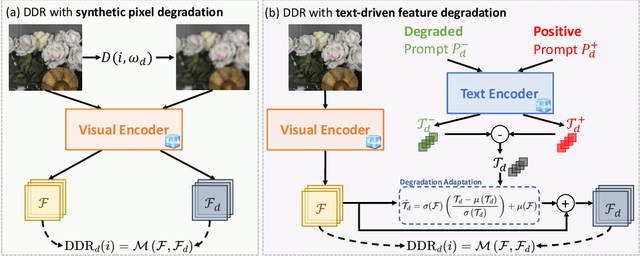
Abstract:Image deep features extracted by pre-trained networks are known to contain rich and informative representations. In this paper, we present Deep Degradation Response (DDR), a method to quantify changes in image deep features under varying degradation conditions. Specifically, our approach facilitates flexible and adaptive degradation, enabling the controlled synthesis of image degradation through text-driven prompts. Extensive evaluations demonstrate the versatility of DDR as an image descriptor, with strong correlations observed with key image attributes such as complexity, colorfulness, sharpness, and overall quality. Moreover, we demonstrate the efficacy of DDR across a spectrum of applications. It excels as a blind image quality assessment metric, outperforming existing methodologies across multiple datasets. Additionally, DDR serves as an effective unsupervised learning objective in image restoration tasks, yielding notable advancements in image deblurring and single-image super-resolution. Our code will be made available.
Opinion-Unaware Blind Image Quality Assessment using Multi-Scale Deep Feature Statistics
May 29, 2024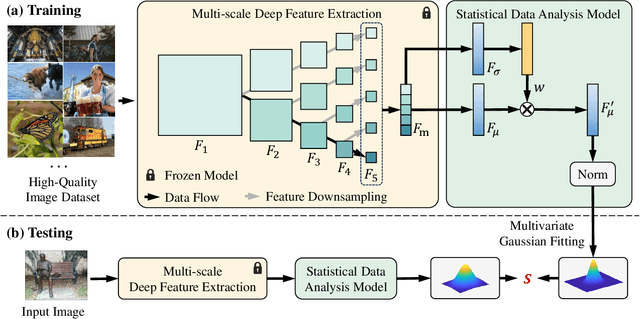
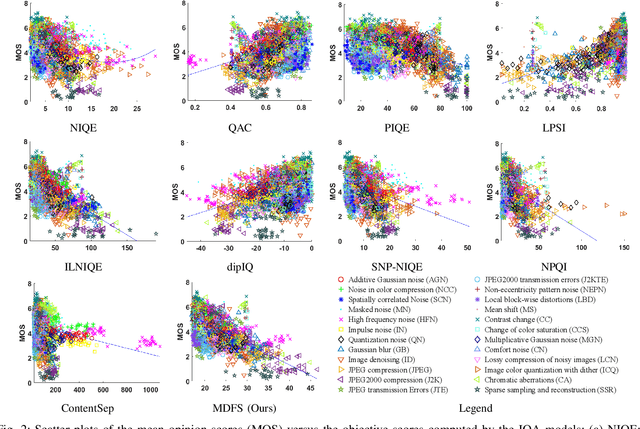

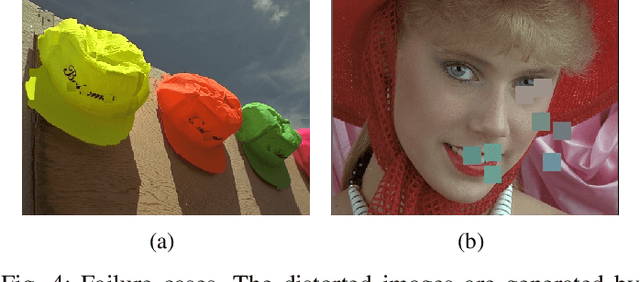
Abstract:Deep learning-based methods have significantly influenced the blind image quality assessment (BIQA) field, however, these methods often require training using large amounts of human rating data. In contrast, traditional knowledge-based methods are cost-effective for training but face challenges in effectively extracting features aligned with human visual perception. To bridge these gaps, we propose integrating deep features from pre-trained visual models with a statistical analysis model into a Multi-scale Deep Feature Statistics (MDFS) model for achieving opinion-unaware BIQA (OU-BIQA), thereby eliminating the reliance on human rating data and significantly improving training efficiency. Specifically, we extract patch-wise multi-scale features from pre-trained vision models, which are subsequently fitted into a multivariate Gaussian (MVG) model. The final quality score is determined by quantifying the distance between the MVG model derived from the test image and the benchmark MVG model derived from the high-quality image set. A comprehensive series of experiments conducted on various datasets show that our proposed model exhibits superior consistency with human visual perception compared to state-of-the-art BIQA models. Furthermore, it shows improved generalizability across diverse target-specific BIQA tasks. Our code is available at: https://github.com/eezkni/MDFS
Octree-GS: Towards Consistent Real-time Rendering with LOD-Structured 3D Gaussians
Mar 26, 2024Abstract:The recent 3D Gaussian splatting (3D-GS) has shown remarkable rendering fidelity and efficiency compared to NeRF-based neural scene representations. While demonstrating the potential for real-time rendering, 3D-GS encounters rendering bottlenecks in large scenes with complex details due to an excessive number of Gaussian primitives located within the viewing frustum. This limitation is particularly noticeable in zoom-out views and can lead to inconsistent rendering speeds in scenes with varying details. Moreover, it often struggles to capture the corresponding level of details at different scales with its heuristic density control operation. Inspired by the Level-of-Detail (LOD) techniques, we introduce Octree-GS, featuring an LOD-structured 3D Gaussian approach supporting level-of-detail decomposition for scene representation that contributes to the final rendering results. Our model dynamically selects the appropriate level from the set of multi-resolution anchor points, ensuring consistent rendering performance with adaptive LOD adjustments while maintaining high-fidelity rendering results.
Misalignment-Robust Frequency Distribution Loss for Image Transformation
Feb 28, 2024Abstract:This paper aims to address a common challenge in deep learning-based image transformation methods, such as image enhancement and super-resolution, which heavily rely on precisely aligned paired datasets with pixel-level alignments. However, creating precisely aligned paired images presents significant challenges and hinders the advancement of methods trained on such data. To overcome this challenge, this paper introduces a novel and simple Frequency Distribution Loss (FDL) for computing distribution distance within the frequency domain. Specifically, we transform image features into the frequency domain using Discrete Fourier Transformation (DFT). Subsequently, frequency components (amplitude and phase) are processed separately to form the FDL loss function. Our method is empirically proven effective as a training constraint due to the thoughtful utilization of global information in the frequency domain. Extensive experimental evaluations, focusing on image enhancement and super-resolution tasks, demonstrate that FDL outperforms existing misalignment-robust loss functions. Furthermore, we explore the potential of our FDL for image style transfer that relies solely on completely misaligned data. Our code is available at: https://github.com/eezkni/FDL
ColNeRF: Collaboration for Generalizable Sparse Input Neural Radiance Field
Dec 15, 2023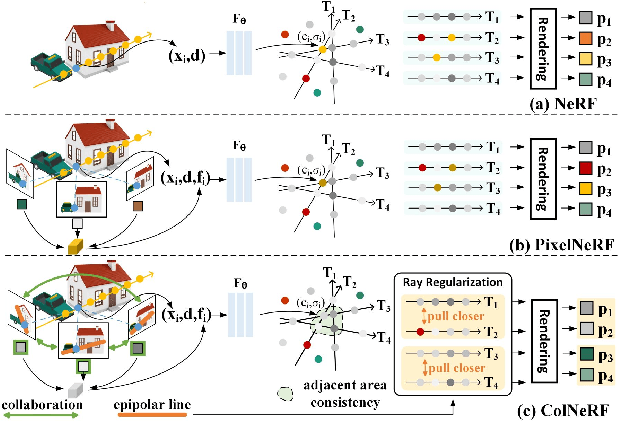



Abstract:Neural Radiance Fields (NeRF) have demonstrated impressive potential in synthesizing novel views from dense input, however, their effectiveness is challenged when dealing with sparse input. Existing approaches that incorporate additional depth or semantic supervision can alleviate this issue to an extent. However, the process of supervision collection is not only costly but also potentially inaccurate, leading to poor performance and generalization ability in diverse scenarios. In our work, we introduce a novel model: the Collaborative Neural Radiance Fields (ColNeRF) designed to work with sparse input. The collaboration in ColNeRF includes both the cooperation between sparse input images and the cooperation between the output of the neural radiation field. Through this, we construct a novel collaborative module that aligns information from various views and meanwhile imposes self-supervised constraints to ensure multi-view consistency in both geometry and appearance. A Collaborative Cross-View Volume Integration module (CCVI) is proposed to capture complex occlusions and implicitly infer the spatial location of objects. Moreover, we introduce self-supervision of target rays projected in multiple directions to ensure geometric and color consistency in adjacent regions. Benefiting from the collaboration at the input and output ends, ColNeRF is capable of capturing richer and more generalized scene representation, thereby facilitating higher-quality results of the novel view synthesis. Extensive experiments demonstrate that ColNeRF outperforms state-of-the-art sparse input generalizable NeRF methods. Furthermore, our approach exhibits superiority in fine-tuning towards adapting to new scenes, achieving competitive performance compared to per-scene optimized NeRF-based methods while significantly reducing computational costs. Our code is available at: https://github.com/eezkni/ColNeRF.
Just Noticeable Difference Modeling for Face Recognition System
Sep 13, 2022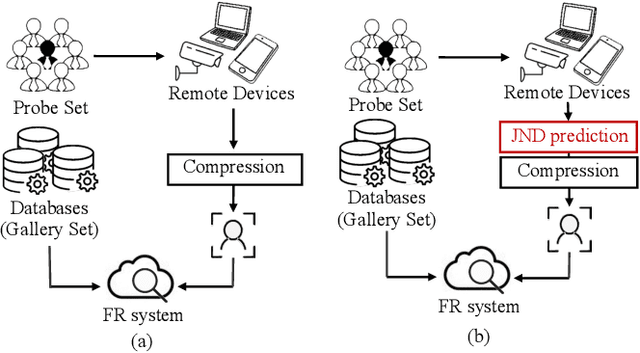
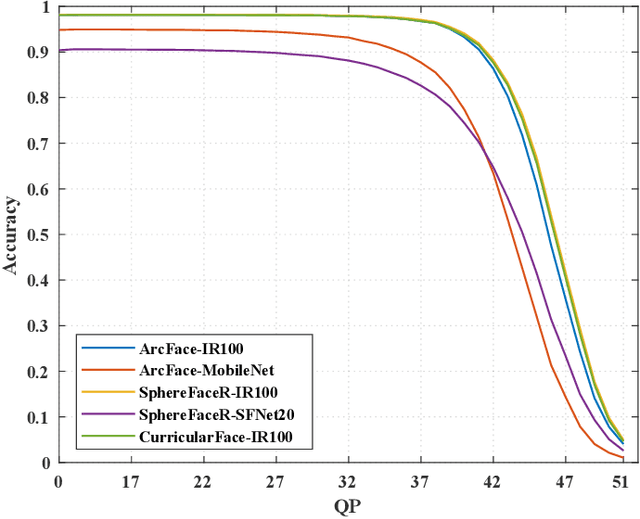
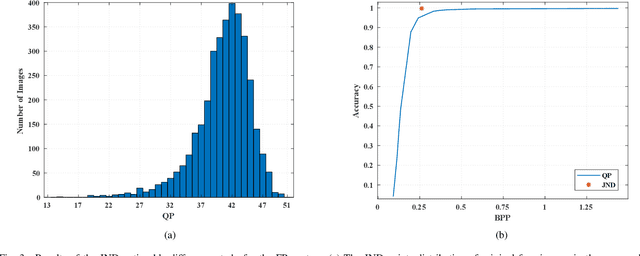
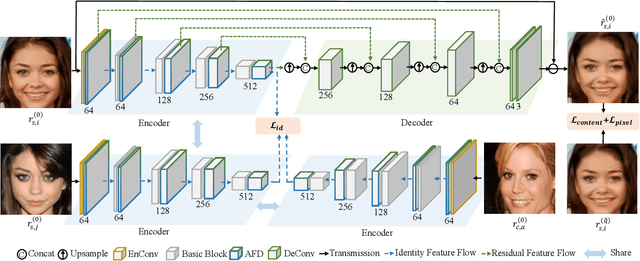
Abstract:High-quality face images are required to guarantee the stability and reliability of automatic face recognition (FR) systems in surveillance and security scenarios. However, a massive amount of face data is usually compressed before being analyzed due to limitations on transmission or storage. The compressed images may lose the powerful identity information, resulting in the performance degradation of the FR system. Herein, we make the first attempt to study just noticeable difference (JND) for the FR system, which can be defined as the maximum distortion that the FR system cannot notice. More specifically, we establish a JND dataset including 3530 original images and 137,670 compressed images generated by advanced reference encoding/decoding software based on the Versatile Video Coding (VVC) standard (VTM-15.0). Subsequently, we develop a novel JND prediction model to directly infer JND images for the FR system. In particular, in order to maximum redundancy removal without impairment of robust identity information, we apply the encoder with multiple feature extraction and attention-based feature decomposition modules to progressively decompose face features into two uncorrelated components, i.e., identity and residual features, via self-supervised learning. Then, the residual feature is fed into the decoder to generate the residual map. Finally, the predicted JND map is obtained by subtracting the residual map from the original image. Experimental results have demonstrated that the proposed model achieves higher accuracy of JND map prediction compared with the state-of-the-art JND models, and is capable of saving more bits while maintaining the performance of the FR system compared with VTM-15.0.
High Dynamic Range Image Quality Assessment Based on Frequency Disparity
Sep 06, 2022


Abstract:In this paper, a novel and effective image quality assessment (IQA) algorithm based on frequency disparity for high dynamic range (HDR) images is proposed, termed as local-global frequency feature-based model (LGFM). Motivated by the assumption that the human visual system is highly adapted for extracting structural information and partial frequencies when perceiving the visual scene, the Gabor and the Butterworth filters are applied to the luminance of the HDR image to extract local and global frequency features, respectively. The similarity measurement and feature pooling are sequentially performed on the frequency features to obtain the predicted quality score. The experiments evaluated on four widely used benchmarks demonstrate that the proposed LGFM can provide a higher consistency with the subjective perception compared with the state-of-the-art HDR IQA methods. Our code is available at: \url{https://github.com/eezkni/LGFM}.
 Add to Chrome
Add to Chrome Add to Firefox
Add to Firefox Add to Edge
Add to Edge